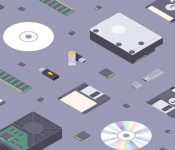What is ROM?
ROM (read-only memory) is a non-volatile memory type. This means it receives data and permanently writes it on a chip, and it lasts even after you turn off your computer. The data is coded to not be overwritten, so it's used for things like your printer software or your startup programs. You can't change your ROM data just by doing ordinary computer activities.In fact, you can’t actually directly access data stored in the ROM. If you need data from the ROM, you must first transfer it to the RAM, where your processor can then access it.
Types of ROM
Most consumers won’t need to worry about the types of ROM, but it may be useful to know the terms so that you can easily identify that it is, indeed, a ROM storage option. Here are each of the types of ROM.⦁ Mask ROM: ROM that is “masked off,” or covered by opaque plates called photomasks.
⦁ PROM: Programmable read-only memory.
⦁ EEPROM: Electronically erasable programmable read-only memory.
⦁ EPROM: Erasable programmable read-only memory.
Each type of ROM is programmed uniquely to its type, and it requires special conditions to be erased or rewritten. EPROM, for example, needs UV light to erase the data, while EEPROM uses a special circuit to rewrite data. Each type is also favored for particular uses. PROM, for example, is used in BIOS applications. Mask ROM is generally used for firmware.

